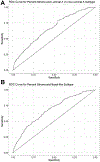Quantitative analysis of breast cancer tissue composition and associations with tumor subtype
- PMID: 35218811
- PMCID: PMC9050931
- DOI: 10.1016/j.humpath.2022.02.013
Quantitative analysis of breast cancer tissue composition and associations with tumor subtype
Abstract
The tumor microenvironment is an important determinant of breast cancer progression, but standard methods for describing the tumor microenvironment are lacking. Measures of microenvironment composition such as stromal area and immune infiltrate are labor-intensive and few large studies have systematically collected this data. However, digital histologic approaches are becoming more widely available, allowing high-throughput, quantitative estimation. We applied such methods to tissue microarrays of tumors from 1687 women (mean 4 cores per case) in the Carolina Breast Cancer Study Phase 3. Tumor composition was quantified as percentage of epithelium, stroma, adipose, and lymphocytic infiltrate (with the latter as presence/absence using a ≥1% cutoff). Composition proportions and presence/absence were evaluated in association with clinical and molecular features of breast cancer (intrinsic subtype and RNA-based risk of recurrence [ROR] scores) using multivariable linear and logistic regression. Lower stromal content was associated with aggressive tumor phenotypes, including triple-negative (31.1% vs. 41.6% in HR+/HER2-; RFD [95% CI]: -10.5%, [-13.1, -7.9]), Basal-like subtypes (29.0% vs. 44.0% in Luminal A; RFD [95% CI]: -14.9%, [-17.8, -12.0]), and high RNA-based PAM50 ROR scores (27.6% vs. 48.1% in ROR low; RFD [95% CI]: -20.5%, [24.3, 16.7]), after adjusting for age and race. HER2+ tumors also had lower stromal content, particularly among RNA-based HER2-enriched (35.2% vs. 44.0% in Luminal A; RFD [95% CI]: -8.8%, [-13.8, -3.8]). Similar associations were observed between immune infiltrate and tumor phenotypes. Quantitative digital image analysis of the breast cancer microenvironment showed significant associations with demographic characteristics and biological indicators of aggressive behavior.
Keywords: Breast cancer; Digital histology; Microenvironment; Pathology; Stroma; Tumor-infiltrating lymphocytes (TILs).
Copyright © 2022 The Authors. Published by Elsevier Inc. All rights reserved.
Conflict of interest statement
Conflicts of interest
Dr. Calhoun is a member of the Oncology Advisory Board for Luminex Corp. All other authors declare that there are no conflicts of interest to report.
The University of North Carolina, Chapel Hill has a license of intellectual property interest in GeneCentric Diagnostics and BioClassifier, LLC, which may be used in this study. The University of North Carolina, Chapel Hill may benefit from this interest that is/are related to this research. The terms of this arrangement have been reviewed and approved by the University of North Carolina, Chapel Hill Conflict of Interest Program in accordance with its conflict of interest policies.
Figures




Similar articles
-
Prognostic significance of different molecular typing methods and immune status based on RNA sequencing in HR-positive and HER2-negative early-stage breast cancer.BMC Cancer. 2022 May 14;22(1):548. doi: 10.1186/s12885-022-09656-4. BMC Cancer. 2022. PMID: 35568835 Free PMC article.
-
Racial Differences in PAM50 Subtypes in the Carolina Breast Cancer Study.J Natl Cancer Inst. 2018 Feb 1;110(2):176-82. doi: 10.1093/jnci/djx135. J Natl Cancer Inst. 2018. PMID: 28859290 Free PMC article.
-
Prognostic value of PAM50 and risk of recurrence score in patients with early-stage breast cancer with long-term follow-up.Breast Cancer Res. 2017 Nov 14;19(1):120. doi: 10.1186/s13058-017-0911-9. Breast Cancer Res. 2017. PMID: 29137653 Free PMC article.
-
Hepatocyte growth factor pathway expression in breast cancer by race and subtype.Breast Cancer Res. 2021 Aug 3;23(1):80. doi: 10.1186/s13058-021-01460-5. Breast Cancer Res. 2021. PMID: 34344422 Free PMC article.
-
Ki67 and lymphocytes in the pretherapeutic core biopsy of primary invasive breast cancer: positive markers of therapy response prediction and superior survival.Horm Mol Biol Clin Investig. 2017 Sep 22;32(2):/j/hmbci.2017.32.issue-2/hmbci-2017-0022/hmbci-2017-0022.xml. doi: 10.1515/hmbci-2017-0022. Horm Mol Biol Clin Investig. 2017. PMID: 28937963 Review.
Cited by
-
The Role of Long Non-Coding RNAs in Modulating the Immune Microenvironment of Triple-Negative Breast Cancer: Mechanistic Insights and Therapeutic Potential.Biomolecules. 2025 Mar 20;15(3):454. doi: 10.3390/biom15030454. Biomolecules. 2025. PMID: 40149989 Free PMC article. Review.
-
Visual Intratumor Heterogeneity and Breast Tumor Progression.Cancers (Basel). 2024 Jun 21;16(13):2294. doi: 10.3390/cancers16132294. Cancers (Basel). 2024. PMID: 39001357 Free PMC article.
-
Deep Learning Glioma Grading with the Tumor Microenvironment Analysis Protocol for Comprehensive Learning, Discovering, and Quantifying Microenvironmental Features.J Imaging Inform Med. 2024 Aug;37(4):1711-1727. doi: 10.1007/s10278-024-01008-x. Epub 2024 Feb 27. J Imaging Inform Med. 2024. PMID: 38413460 Free PMC article.
-
Differences in 21-Gene and PAM50 Recurrence Scores in Younger and Black Women With Breast Cancer.JCO Precis Oncol. 2024 Jul;8:e2400137. doi: 10.1200/PO.24.00137. JCO Precis Oncol. 2024. PMID: 39013134 Free PMC article.
-
The Landscape of Immune Microenvironments in Racially Diverse Breast Cancer Patients.Cancer Epidemiol Biomarkers Prev. 2022 Jul 1;31(7):1341-1350. doi: 10.1158/1055-9965.EPI-21-1312. Cancer Epidemiol Biomarkers Prev. 2022. PMID: 35437570 Free PMC article.
References
-
- Newman B, Moorman PG, Millikan R, Qaqish BF, Geradts J, Aldrich TE, Liu ET. The Carolina Breast Cancer Study: integrating population-based epidemiology and molecular biology. Breast Cancer Res Treat 1995;35(1):51–60. - PubMed
-
- Troester MA, Sun X, Allott EH, Geradts J, Cohen SM, Tse CK, Kirk EL, Thorne LB, Mathews M, Li Y, Hu Z, Robinson WR, Hoadley KA, Olopade OI, Reeder-Hayes KE, Earp HS, Olshan AF, Carey LA, Perou CM. Racial Differences in PAM50 Subtypes in the Carolina Breast Cancer Study. J Natl Cancer Inst 2018;110(2). - PMC - PubMed
-
- Ehteshami Bejnordi B, Mullooly M, Pfeiffer RM, Fan S, Vacek PM, Weaver DL, Herschorn S, Brinton LA, van Ginneken B, Karssemeijer N, Beck AH, Gierach GL, van der Laak J, Sherman ME. Using deep convolutional neural networks to identify and classify tumor-associated stroma in diagnostic breast biopsies. Mod Pathol 2018;31(10):1502–12. - PMC - PubMed
Publication types
MeSH terms
Substances
Grants and funding
LinkOut - more resources
Full Text Sources
Medical
Research Materials
Miscellaneous

